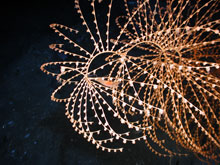Lophelia II 2008: Deepwater Coral Expedition: Reefs, Rigs, and Wrecks

This is the first cruise of a 4-year project funded by the US Mineral Management Service (MMS) and the NOAA Office of Ocean Exploration and Research (OER) to explore new deepwater coral communities at both natural and man-made sites. The goal of this project is to discover new coral sites in the deep Gulf of Mexico and characterize them in terms of coral habitat characteristics, biology, ecology, and genetic connectivity.
The diverse group of experienced investigators on this project will use a combination of remote sensing, photographic sampling, quantitative community collections, live coral manipulative experiments, geologic characterization, oceanographic measurements, and genetic analyses to further our understanding of cold water corals and the communities associated with them.
This is the first year of the project and the second leg of this cruise investigating a series of previously unexplored sites along the northern Gulf of Mexico between 300 and 1000m.
The initial phase of this project has consisted of poring over the extensive bathymetric and 3-dimensional seismic data held by MMS to select the sites they will be visiting. Although past surveys have generated a series of good maps of these sites, they will be the first eye on the bottom at almost all of their sites.
The first leg of this year's cruise examined ship wrecks and the corals colonizing them. During this second leg, they will be using the NOAA Ship Nancy Foster and the SeaEye Falcon ROV to scout out these new sites, run large scale photographic surveys and make collections of a few key species.
In the spring they plan to mount a second expedition to explore additional new sites, many in waters deeper than 1000m. In the second and third years of the project they will also conduct additional mapping surveys and examinations of coral colonization on oil rigs.
The third and fourth cruises will be larger interdisciplinary expeditions where much of the intensive physical and photographic sampling of the coral species and associated communities will take place.
 Deep Sea Crabs
Deep Sea Crabs